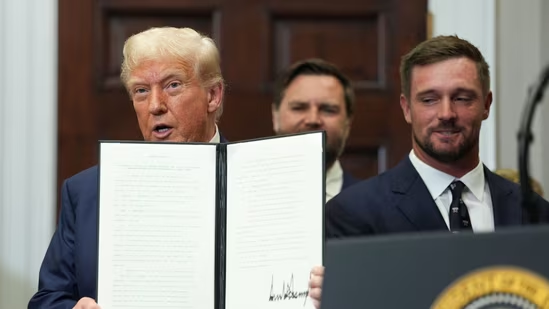1 Aug 2025 : Donald Trump has introduced a fresh set of tariff rates on numerous countries, many of which now face significantly higher duties on their exports to the United States starting August 7. The move could pose a serious challenge to global economies, especially since several countries are yet to finalise trade agreements with the Trump administration. A minimum 10% tariff now applies globally.
On Thursday, the White House released a list of nations subject to new tariffs ranging from 10% to 41%. Countries not listed will still face a standard 10% duty on exports to the US.
Trump had earlier threatened to impose the tariffs from August 1, but postponed them by a week just hours before the deadline.
Some of America’s key trading partners — including the European Union, the United Kingdom, and Japan — have reached deals or are close to doing so. Yet, even they are facing higher duties than before Trump’s presidency. Meanwhile, countries such as China and Mexico have received deadline extensions but are still expected to pay more eventually.
Trump argues that the tariffs will help revive US manufacturing and push other nations to lower trade barriers for American goods. “There’s 200 countries,” he said earlier this month. “You can’t talk to all of them.”
Despite Trump’s claim that foreign exporters will bear the brunt, economists, according to Associated Press, say that US businesses are mostly footing the bill, with inflation rising as imported goods like furniture and electronics become costlier.
Nations without agreements are being hit with tariffs ranging from 10% to 40%, including large economies such as India, Canada, and Taiwan, and smaller ones like South Africa, Sri Lanka, Bangladesh — and even tiny Lesotho.
The US has granted Mexico a 90-day extension due to the complex nature of its trade ties, governed by the updated USMCA deal from Trump’s first term.
Smaller nations have been particularly vulnerable. Lesotho, a small African kingdom, had already been hit with a 50% tariff on 2 April — though later postponed. Even the threat alone has devastated its apparel sector, causing widespread job losses. On Thursday, the country was slapped with a 15% duty.
Countries with US trade agreements
In a burst of last-minute negotiations, Trump has been announcing trade deals right up to Thursday, though most lack concrete specifics.
On Thursday, the US and Pakistan finalised a trade agreement that is expected to enable Washington to assist in developing Pakistan’s largely unexplored oil reserves while reducing tariffs for the South Asian nation.
And on Wednesday, Trump revealed a deal with South Korea, which will see a 15% tariff imposed on Korean goods — notably lower than the 25% rate he had threatened back in April.
Trade agreements have also been concluded with the European Union, the United Kingdom, Pakistan, Indonesia, Vietnam, and the Philippines. However, the deal with the Philippines brought only a marginal relief, cutting its tariff rate from 20% to 19%.
Which countries don’t have a deal?
Of the 68 nations listed in Trump’s executive order, along with the EU, most have yet to secure deals. These include Algeria, now facing a 30% tariff; Iraq at 35%; Syria at 41%; Switzerland at 39%; and Taiwan at 20%.
Trump had already imposed steep duties on Brazil and India prior to the August deadline. On Wednesday night, he signed an order placing a 50% tariff on Brazilian imports, exempting key sectors such as aircraft, aluminium, and energy. India, meanwhile, faces a 25% tariff, partly due to its ongoing oil trade with Russia.
Smaller countries have been particularly impacted, with limited ability to negotiate. Lesotho, for instance, was hit with a 50% tariff in April. Although delayed, it still faces a 15% duty and has seen severe job losses in its apparel sector.
“There’s 200 countries,” the president acknowledged earlier this month. “You can’t talk to all of them.”
Will the deadline hold this time?
By Thursday afternoon, both White House officials and Trump had insisted that no additional delays would be allowed.
Yet, later in the evening, when Trump signed the order imposing new tariffs on 68 countries and the European Union, the start date was pushed back by seven days to accommodate updates to the tariff schedule. Although this short postponement may offer some respite to countries still negotiating deals with the US, it has also stirred fresh uncertainty among businesses and consumers who remain unclear about what exactly will happen and when it will begin.
Summary:
New Trump-era tariffs ranging from 10% to 41% take effect August 7. Countries without trade deals face higher duties on goods exported to the US.


